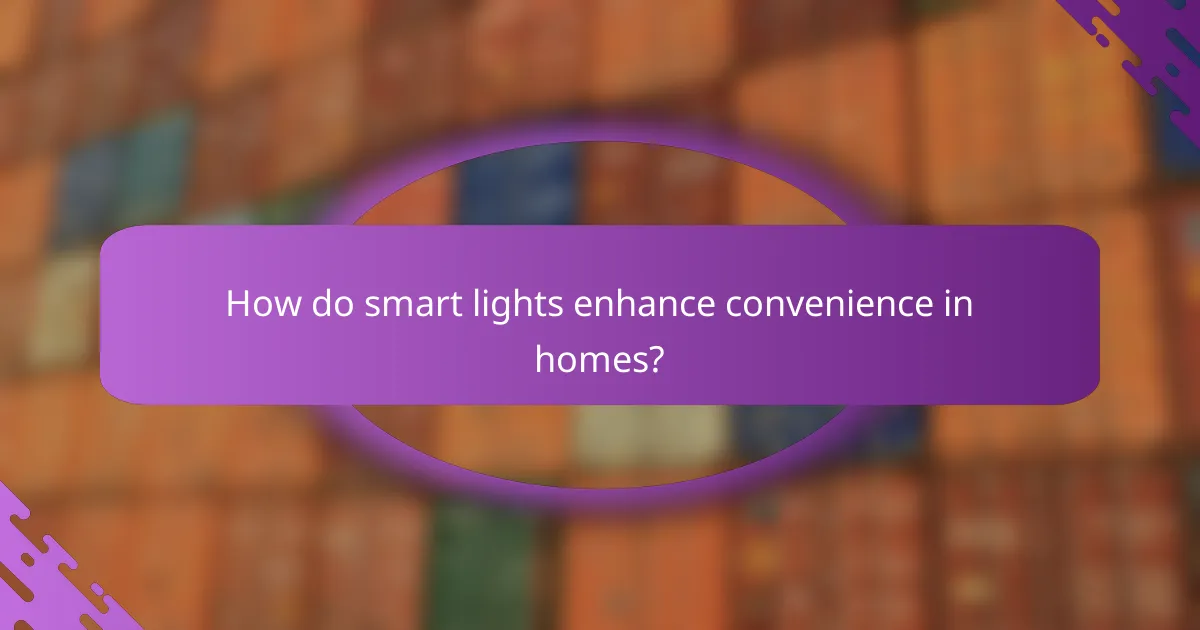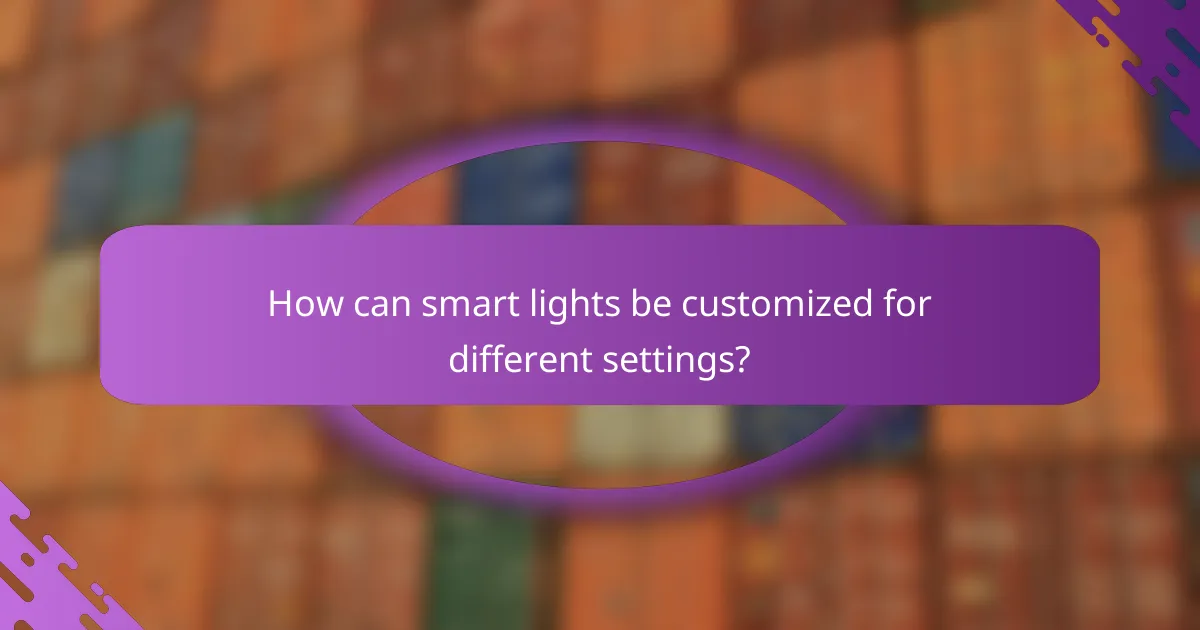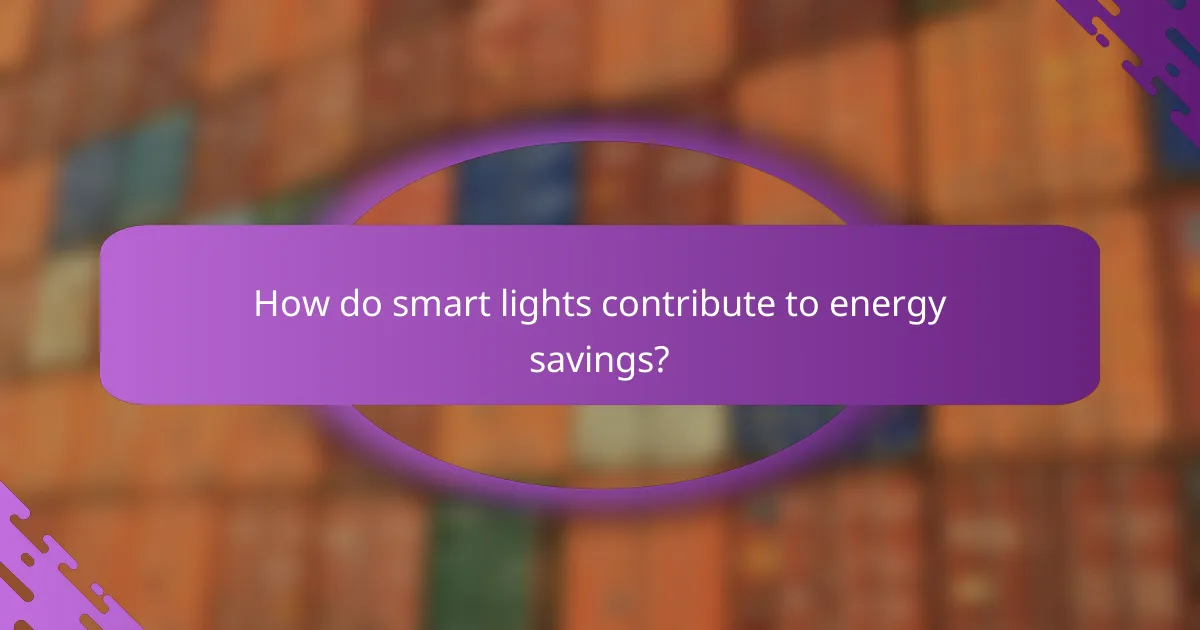Smart lights revolutionize home lighting by providing remote control, automation, and voice command integration, enhancing convenience and energy efficiency. With energy monitoring features, users can track their electricity consumption and optimize usage for cost savings. Additionally, customizable settings and scene presets allow smart lights to adapt to various environments and activities, further improving the overall user experience.

How do smart lights enhance convenience in homes?
Smart lights significantly enhance convenience in homes by allowing users to control their lighting remotely, automate schedules, and integrate voice commands. These features simplify daily routines and improve energy efficiency, making it easier to manage home environments.
Remote control via smartphone apps
Smart lights can be controlled from anywhere using dedicated smartphone apps. Users can turn lights on or off, adjust brightness, and change colors with just a few taps, providing flexibility and ease of use.
Many apps also allow for the creation of lighting scenes or presets, enabling users to set the mood for different activities, such as reading or entertaining. This remote capability is particularly useful for managing lights when away from home.
Voice activation with Amazon Alexa
Integrating smart lights with voice assistants like Amazon Alexa offers hands-free control. Users can simply say commands such as “turn on the living room lights” or “dim the bedroom lights,” making it convenient for multitasking or when hands are full.
This feature enhances accessibility, especially for individuals with mobility challenges. Voice control can also be combined with routines, allowing users to set multiple actions with a single command.
Automated scheduling for lighting
Automated scheduling allows users to set specific times for lights to turn on or off, which can enhance security and energy savings. For instance, lights can be programmed to turn on at sunset and off at bedtime, creating a natural rhythm in the home.
Users can also set different schedules for weekdays and weekends, ensuring that lighting aligns with their lifestyle. This feature helps reduce energy consumption by ensuring lights are only on when needed.

What are the energy monitoring features of smart lights?
Smart lights offer various energy monitoring features that help users track and manage their electricity consumption. These features provide insights into energy usage patterns, enabling more efficient lighting management and potential cost savings.
Real-time energy consumption tracking
Real-time energy consumption tracking allows users to see how much electricity their smart lights are using at any given moment. This feature typically displays usage in watts or kilowatts, providing immediate feedback on energy expenditure. For example, a smart bulb might show a usage of 10 watts when on, helping users make informed decisions about when to turn lights off.
Many smart lighting systems offer mobile apps that display this real-time data, making it easy to monitor energy use from anywhere. Users can set alerts to notify them if energy consumption exceeds a certain threshold, promoting proactive energy management.
Energy usage reports and analytics
Energy usage reports and analytics provide a comprehensive overview of lighting consumption over time. These reports often summarize daily, weekly, or monthly usage, allowing users to identify trends and peak usage times. For instance, a report might reveal that lights are used most frequently in the evening, highlighting opportunities for energy savings.
Some systems even offer comparisons to previous periods, helping users see the impact of changes in behavior or settings. This data can be invaluable for budgeting electricity costs, especially in regions where energy prices fluctuate significantly.
Integration with smart home energy systems
Smart lights can integrate seamlessly with broader smart home energy systems, enhancing overall energy management. This integration allows for coordinated control of lighting alongside other devices, such as thermostats and appliances, optimizing energy use across the home. For example, lights can automatically dim or turn off when a smart thermostat detects that no one is home.
Additionally, users can create routines that adjust lighting based on energy pricing signals, reducing usage during peak hours when electricity costs are higher. This capability not only saves money but also contributes to a more sustainable energy footprint.

How can smart lights be customized for different settings?
Smart lights can be tailored to fit various environments and activities through adjustable settings, scene presets, and integration with other smart home devices. This customization enhances convenience, energy efficiency, and overall user experience.
Adjustable brightness and color temperature
Smart lights allow users to modify brightness levels and color temperatures to suit different moods or tasks. For instance, a warm color temperature (around 2700K) is ideal for relaxation, while cooler temperatures (up to 5000K) are better for focused work. Users can typically adjust brightness from a dim glow to full brightness, offering flexibility for various settings.
To achieve the desired ambiance, consider using a dimmer function that can reduce brightness in the evening or increase it during the day. Many smart lighting systems also provide apps or voice control for easy adjustments.
Scene settings for various activities
Scene settings allow users to create specific lighting configurations for different activities, such as reading, watching movies, or hosting gatherings. For example, a “Movie Night” scene might dim the lights and set them to a soft blue, while a “Reading” scene could brighten the space with a warm white light.
Creating these scenes is often straightforward through smart lighting apps, where users can save their preferred settings and activate them with a single command. This feature enhances convenience and helps set the right mood effortlessly.
Integration with smart home ecosystems
Smart lights can seamlessly integrate with various smart home ecosystems, such as Google Home, Amazon Alexa, or Apple HomeKit. This integration allows for voice control and automation, enabling users to manage their lighting alongside other smart devices.
For instance, you can set your smart lights to turn on automatically when you arrive home or to adjust based on the time of day. Ensure compatibility with your existing devices and consider using routines to maximize the benefits of integration.

What are the best smart light brands available in the market?
The best smart light brands combine convenience, energy monitoring, and customizable settings to enhance your home lighting experience. Popular options include Philips Hue, Wyze, and LIFX, each offering unique features and price points to suit different needs.
Philips Hue for versatile options
Philips Hue is renowned for its extensive range of smart lighting products that cater to various preferences and settings. Users can choose from bulbs, light strips, and fixtures that can be easily integrated into existing home systems.
This brand supports a wide array of colors and white light temperatures, allowing for personalized ambiance. Philips Hue lights can be controlled via a smartphone app or voice commands, making them highly convenient.
Wyze for budget-friendly solutions
Wyze offers smart lighting solutions that are both affordable and functional, making them an excellent choice for budget-conscious consumers. Their smart bulbs provide essential features like app control and scheduling without breaking the bank.
While Wyze may not have the extensive color options of higher-end brands, their products still deliver reliable performance and energy efficiency, making them suitable for everyday use.
LIFX for vibrant color choices
LIFX stands out for its impressive color range and brightness levels, appealing to users who prioritize vibrant lighting. These smart bulbs do not require a hub, allowing for straightforward installation and setup.
With LIFX, users can access a variety of lighting effects and integrations with other smart home devices. This brand is ideal for those looking to create dynamic lighting scenes and enhance their home decor.

What criteria should you consider when selecting smart lights?
When selecting smart lights, consider compatibility with your existing smart home devices, the range of color and brightness options available, and the ease of installation and setup. These factors will significantly impact your overall experience and satisfaction with the smart lighting system.
Compatibility with existing smart home devices
Ensure that the smart lights you choose are compatible with your current smart home ecosystem, such as Amazon Alexa, Google Assistant, or Apple HomeKit. This compatibility allows for seamless integration and control through a single app or voice commands.
Check for specific protocols like Zigbee or Z-Wave, as these can affect connectivity. If you already have devices from a particular brand, it may be beneficial to stick with that brand for your smart lighting to avoid compatibility issues.
Range of color and brightness options
Smart lights come with varying capabilities in terms of color and brightness. Some models offer millions of colors and adjustable brightness levels, allowing you to customize the ambiance of your space. Others may only provide a limited color palette or fixed brightness settings.
Consider your needs: if you want dynamic lighting for different occasions, opt for lights with extensive color options. For basic functionality, simpler models may suffice and often come at a lower price point.
Ease of installation and setup
Installation and setup can vary significantly between smart light brands and models. Some lights simply screw into existing fixtures, while others may require additional hardware or wiring. Look for lights that offer straightforward installation processes to save time and hassle.
Check user reviews for insights on the setup experience. Many smart lights come with apps that guide you through the installation, but ensure that the app is user-friendly and well-rated to avoid frustration during setup.

How do smart lights contribute to energy savings?
Smart lights significantly enhance energy savings through advanced technologies that optimize electricity usage. By utilizing features like LED technology, dimming capabilities, and scheduling, these lights can reduce overall consumption and lower utility bills.
LED technology for lower energy consumption
Smart lights often use LED technology, which is known for its efficiency compared to traditional incandescent bulbs. LEDs consume up to 80% less energy, translating to substantial savings over time, especially in high-use areas like living rooms or kitchens.
When selecting smart lights, look for those with Energy Star ratings, as they meet strict energy efficiency guidelines. This ensures that you are choosing products that not only save energy but also provide long-lasting performance.
Smart dimming features to reduce usage
Many smart lighting systems include dimming features that allow users to adjust brightness levels according to their needs. Lowering the brightness can lead to significant energy savings, as lights consume less power when dimmed.
For practical use, consider setting your smart lights to dim during evenings or when natural light is available. This simple adjustment can reduce energy consumption by up to 50%, depending on the brightness level selected.
Scheduling to avoid unnecessary usage
Smart lights can be programmed to turn on or off at specific times, preventing unnecessary energy use. Scheduling is particularly useful for areas that are not frequently occupied, such as hallways or outdoor spaces.
To maximize savings, set your smart lights to turn off automatically during the night or when you are away from home. This can help ensure that lights are not left on longer than needed, contributing to lower energy bills.
